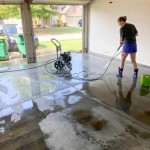How to Remove Motor Oil From Concrete Garage Floor
Motor oil spills are a common occurrence in garages, and they can leave unsightly stains and a slick surface that poses a safety hazard. Fortunately, with the right approach, you can effectively remove motor oil from your concrete garage floor and restore its cleanliness and safety. This article will guide you through the process, providing step-by-step instructions and valuable tips for tackling this common problem.
Preparation and Safety
Before you begin cleaning, it's crucial to prepare the area and ensure your safety. Start by wearing protective gear, including gloves, eye protection, and a mask to prevent exposure to harmful chemicals. Adequate ventilation is vital during cleaning. Open windows and doors to allow fresh air circulation, especially if you're using harsh chemicals. If the spill is extensive, consider using a respirator for enhanced protection.
Next, assess the spill and its size. For small spills, you may be able to absorb the oil directly with absorbent materials like kitty litter, sawdust, or an oil absorbent pad. These materials will soak up the oil, making it easier to dispose of later. For larger spills, you'll need a more comprehensive cleaning approach.
Cleaning Methods for Motor Oil Removal
There are several methods for removing motor oil from concrete, each suited for different situations. The choice depends on the severity of the spill, the type of concrete, and your personal preferences. Here are some common options:
1. Absorbent Materials
For fresh spills, absorbent materials are a quick and effective solution. Sprinkle the affected area generously with kitty litter, sawdust, or oil absorbent pads. Allow the material to absorb the oil for several minutes, then carefully scoop it up and discard it in a sealed container. Repeat the process until most of the oil is absorbed.
2. Degreaser and Water
Degreasers are readily available cleaning agents designed for removing grease and oil from surfaces. A degreaser works by breaking down the oil molecules, making it easier to remove. Apply the degreaser according to the instructions on the product label, typically by spraying it onto the affected area. Allow it to sit for a few minutes to work its magic, then scrub the surface with a brush or a stiff-bristled broom. Rinse thoroughly with water, and repeat the process if necessary.
For stubborn stains, use a stronger degreaser, such as a commercial-grade product specifically for oil stains. Be sure to follow the manufacturer's instructions closely for safe and effective use.
3. Baking Soda and Vinegar
For environmentally friendly cleaning, consider using a mixture of baking soda and vinegar. Sprinkle baking soda generously over the oil stain, followed by a generous amount of vinegar. The mixture will create a fizzing action that helps break down the oil. Let it sit for 15 to 20 minutes, then scrub the area with a brush and rinse with water. Repeat as needed until the stain is gone.
4. Mineral Spirits
In some cases, mineral spirits can effectively remove stubborn oil stains. Apply a small amount of mineral spirits to a clean cloth and dab the stain gently. Avoid excessive rubbing, as this can spread the oil further. Once the stain is removed, rinse the area thoroughly with water and allow it to dry completely.
5. Commercial Oil Stain Removers
Numerous commercial oil stain removers are available on the market, formulated specifically for removing oil from concrete. These products often contain powerful cleaning agents that effectively dissolve oil and penetrate deep into the concrete pores. Follow the instructions on the product label carefully for optimal results.
6. Sanding and Sealing
For deeply embedded oil stains that persist even after cleaning, sanding may be necessary. Use sandpaper or a sander to gently remove the top layer of the concrete, taking care not to damage the surface. Once sanded, apply a concrete sealer to protect the floor from future stains.
Post-Cleaning Considerations
After cleaning, it's important to dispose of the cleaning materials properly. Absorbent materials soaked with oil should be placed in sealed containers and disposed of according to local regulations. Degreasers and other chemical cleaners should be handled with caution, and their containers should be stored in a safe place, out of reach of children and pets.
Regular maintenance is key to preventing future oil spills and keeping your garage floor clean and safe. Avoid parking vehicles on the concrete floor when possible, and use a drip pan under your vehicle when performing oil changes. If a spill occurs, address it promptly to prevent it from becoming deeply embedded in the concrete.

Tips To Remove Oil Stains On Your Garage Floor

How To Remove An Oil Stain From Concrete

How To Remove Oil Stains From Concrete Craftsman Floors Polished

How To Remove Oil Stains From Your Garage Floor All Floors

How To Remove Oil Stains From Concrete Driveways Network

How To Remove Oil Stains From Driveway In 5 Steps Prosoco

How To Remove Oil Stains From Concrete Floors Family Handyman

How To Clean Oil Off Concrete Garage Floor Spillfix

Pour N Re Oil Stain Remover Get Rid Of Stains

The Fastest Way To Remove Oil Stains From Driveways And Garage Floors Shorts
Related Posts








